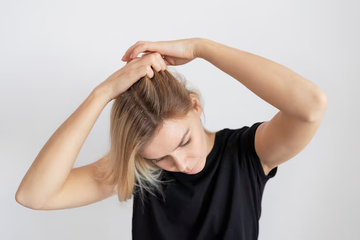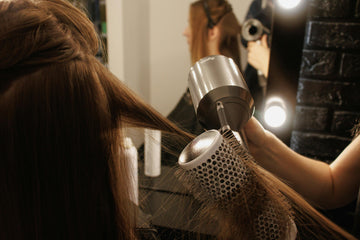Strong isn’t always better—especially when your hair feels like straw
You bought the deep conditioner. The protein mask. The leave-in that promised fortified, damage-resistant strands. You followed the routine. You committed. And now? Your hair feels like a broomstick with abandonment issues. Dry, stiff, impossible to style—and snapping if you so much as look at a comb. Yeah… something’s off.
What no one tells you? You can have too much of a good thing—especially when that thing is protein. And while hair needs protein to stay strong (the main one is called keratin, ICYMI), overloading your routine with strengthening this, fortifying that, and “repairing” everything can leave you with strands that feel rough, rigid, and straight-up crunchy. This is protein overload, and it’s sneakier than your ex in your IG Story views.
To make it worse, the symptoms of protein overload in hair often look a lot like plain old damage, so most of us don’t even realize it’s happening until our curls stop curling and our ends start snapping like dry spaghetti.
Sound familiar?
Then girl, keep reading. We're breaking down what protein overload actually is, how to tell if your hair is in SOS mode, and how to actually fix it, without tossing your entire product shelf or panic-cutting bangs.
What even is protein overload?
So here’s the deal: your hair is mostly made up of a protein called keratin (yep, the same protein found in hair and nails). It’s what gives your strands strength, elasticity, and that satisfying snap-back when your curls are in their prime. It’s also why you see the word “protein” on everything from deep conditioners to edge gels. Sounds great, right?
Here’s where it goes sideways.
When you layer on too much protein in hair, from masks, treatments, leave-ins, stylers, even shampoo, you start to mess with the balance your hair actually needs to thrive. Protein builds up on the hair shaft, forming a hard coating that doesn’t allow moisture in. Your strands might be strong, but they’re also rigid, brittle, and unable to stretch the way healthy hair should.
The result? Hair that feels dry, no matter how much you hydrate. Curls that won’t bounce back. Ends that snap before you even finish brushing. Basically, your hair stops acting like itself.
And no, this isn’t just a curly girl issue (although textured hair can be more sensitive). Anyone—straight, wavy, color-treated, natural, can run into protein overload if the routine is out of balance. It’s not about ditching protein completely, it’s about knowing how much is too much and when your hair is waving a red flag.
So, now that you know what it is, let’s get into the REAL tea.
How do you know if that’s what’s happening to your hair?
The sneaky signs and how to spot it
Here's the wild part. You might already be dealing with protein overload hair symptoms and not even know it. Why? Because the signs are subtle at first and super easy to confuse with damage, dryness, or even a bad product mix. It’s giving mystery villain energy—until you put the pieces together.
Here’s what to watch for.
– Your hair feels like straw
Not just “a bit dry,” we’re talking stiff, coarse, rough-to-the-touch. Like broom bristles. Even right after conditioning.
– Breakage for no reason
Hair snapping halfway down the shaft? Ends breaking like twigs? That brittle texture is a classic symptom of protein overload in hair.
– Your curls are MIA
If your hair used to coil, wave, or bend—and now it just hangs there, limp or puffy—you could be in protein trouble. Protein buildup blocks moisture, which curls desperately need to form.
– Extreme dryness, even after moisturizing
You’ve tried leave-ins, oils, deep conditioners—and your hair still feels bone dry. That’s because the protein coating is locking moisture out.
– Your hair looks dull and matte
If you’ve lost that natural shine and things are looking chalky or dusty, it could be protein residue sitting on your strands.
– More shedding than usual
We’re not talking normal fallout—we’re talking handfuls post-shower or tons of little broken pieces all over your floor.
Still unsure? Here’s a quick test to do at home.
Take one strand of wet hair and stretch it gently. If it snaps right away with no give? You’re dealing with too much protein in your hair. Healthy strands should stretch a bit before bouncing back.
Up next, we’re going to explore what causes this in the first place. Because if your routine is doing the most... your hair might be over it.
Too much protein in hair? Here’s how it happens
Protein overload isn’t some overnight disaster. It’s more like a slow, quiet sabotage—sneaking in through your well-intentioned wash day lineup.
It usually starts when you’re trying to “fix” your hair. Maybe it felt a little dry, so you grabbed a protein-rich mask. Then your leave-in said “strengthening.” So did your shampoo. And your conditioner. And your curl cream. Suddenly, every step of your routine is serving keratin, collagen, or some other buzzword promising stronger, better, shinier hair.
Instead of nourishment, your strands are getting suffocated.
Here’s what makes it worse: protein is often listed as a benefit, not a warning. But if you’re using multiple protein-packed products without balancing them with moisture, you’re creating buildup that acts like armor, stopping hydration from getting in and flexibility from bouncing back. That’s where the crunchiness starts.
Here are some ingredients to keep an eye on.
– Hydrolyzed keratin
– Collagen
– Wheat protein
– Silk protein
– Soy protein
– Amino acids
– “Strengthening,” “fortifying,” or “repairing” on the front label (translation: probably protein-heavy)
Even DIY lovers aren’t safe. Rice water, egg masks, gelatin treatments—natural, sure, but also protein bombs if you’re not pairing them with deep moisture.
The worst part? It can happen even if your hair wasn’t damaged to begin with. Hair that’s already strong or low porosity is more likely to rebel when overloaded. Because it doesn’t need the extra reinforcement—it needs flexibility, softness, and hydration to stay balanced.
So if your hair suddenly feels like it’s rebelling against everything… it might not be breakage or dryness. It might just be too much protein, showing up in every step of your routine.
Let’s clear something else up too, because protein isn’t the only thing your hair can overdose on. Moisture can cause just as much chaos if you’re not careful. So, how do you tell them apart? Keep going.
Protein overload vs. moisture overload (and how to tell)
On paper, they sound like opposites. One means too much protein, the other means too much moisture. Easy, right? Not exactly. They can look almost identical—dull, limp hair that won’t hold a style, curls that disappear, and a general “what is happening on my head?” energy.
But here’s the breakdown you need.
If it’s protein overload, your hair will
– Feel rough, hard, or straw-like
– Snap easily when stretched (no give)
– Look dull, dry, and matte—even after conditioning
– Lose elasticity and feel stiff
– Shed small broken pieces from the mid-strand, not just the root
If it’s moisture overload, your hair will
– Feel overly soft, limp, or mushy
– Stretch a lot before snapping
– Look flat or puffy with zero definition
– Stay wet for hours
– Lose shape quickly after styling (especially curls or waves)
And yes, it’s possible to swing from one to the other if you're overcorrecting. A few protein masks too many, and boom—you’re brittle. Cut protein cold turkey and douse your hair in leave-ins? Now you’re mushy. This is why balance is everything.
The quick test
Take a wet strand, pull gently.
→ If it stretches and immediately snaps: protein overload.
→ If it stretches way too far and turns to mush: moisture overload.
Neither is cute, but both are fixable—once you know which one you’re dealing with. The key is learning to read your hair’s mood, not just what your products say on the label.
Next, it’s time to get practical. Let’s talk exactly how to fix protein overload without having to start your routine from scratch.
How to fix protein overload in hair
So you’ve officially diagnosed it: your hair is dry, stiff, snappy, and definitely suffering from protein overload. The good news? This is completely fixable. The bad news? It won’t happen overnight, but with the right moves, your hair will start acting like itself again.
Step 1: Hit pause on all protein products
This is your detox phase. Take a hard look at every product you’re using—shampoo, conditioner, leave-ins, stylers, even oils. If the ingredient list has anything like hydrolyzed keratin, collagen, soy protein, wheat protein, or amino acids, it’s time to shelf it for now.
You don’t have to toss them forever. Just give your hair a break to rebalance.
Step 2: Bring on the moisture—real moisture
Swap out all protein-heavy formulas for hydration-focused ones. Think water-based conditioners, masks loaded with oils or butters (like shea, coconut, babassu), and creamy leave-ins with humectants like glycerin or aloe.
Moisture is what will soften those brittle strands, restore elasticity, and help your hair bounce back (literally).
Step 3: Use a clarifying shampoo—once
You only need to do this once at the start, but it’s important. A good clarifying wash can remove protein residue, product buildup, and let all that juicy moisture actually soak in.
Just don’t overdo it—clarifying too often can dry your hair out all over again.
Step 4: Deep condition like it’s your full-time job
Grab a rich, non-protein deep conditioner and give your hair a weekly date with hydration. Leave it on for 20–30 minutes (or longer if your hair’s high porosity). Throw on a shower cap. Add steam if you’re fancy.
Your strands need that TLC.
Step 5: Be patient (but consistent)
Protein overload didn’t show up overnight, and it won’t disappear in one wash. Stick with your moisture-focused routine for a few weeks before reintroducing light protein products (if your hair actually needs them).
If you’re still seeing issues after 3–4 weeks of consistent hydration? It may be something else (like moisture overload or breakage from heat/chemical styling).
The goal here isn’t to fear protein forever. It’s to understand that your hair needs balance, and right now, moisture is your main character.
So… is your hair over it?
If your strands feel like they’re rebelling, snapping for no reason, or just refusing to act right, there’s a decent chance they’re not damaged… they’re just protein overloaded. It happens to the best of us, especially when we’re trying to “fix” our hair by loading on every strengthening product in sight.
But now you know the signs. You know how it happens. And more importantly, you know exactly how to turn it around.
You don’t need to panic, big chop, or throw your whole routine in the bin. You just need to give your hair what it’s asking for: balance, hydration, and a little less of the most. For extra help defining curls after recovery, check out our roundup of curl activators that keep hair soft, bouncy, and moisturized.
Your protein overload survival guide
☑️ Stop using protein-heavy products
☑️ Clarify gently (once!) to reset
☑️ Deep condition weekly with rich, moisture-based formulas
☑️ Stick to hydration-focused routines for at least 2–3 weeks
☑️ Reintroduce protein slowly—and only if your hair needs it
Protein isn’t the enemy here, girlie. But like any good thing, too much can tip the scales. And when your hair feels off, dry, or totally out of character? Listen to it. Adjust. Reset. You’ve got the tools—and now, the knowledge—to get your hair back to its best.




